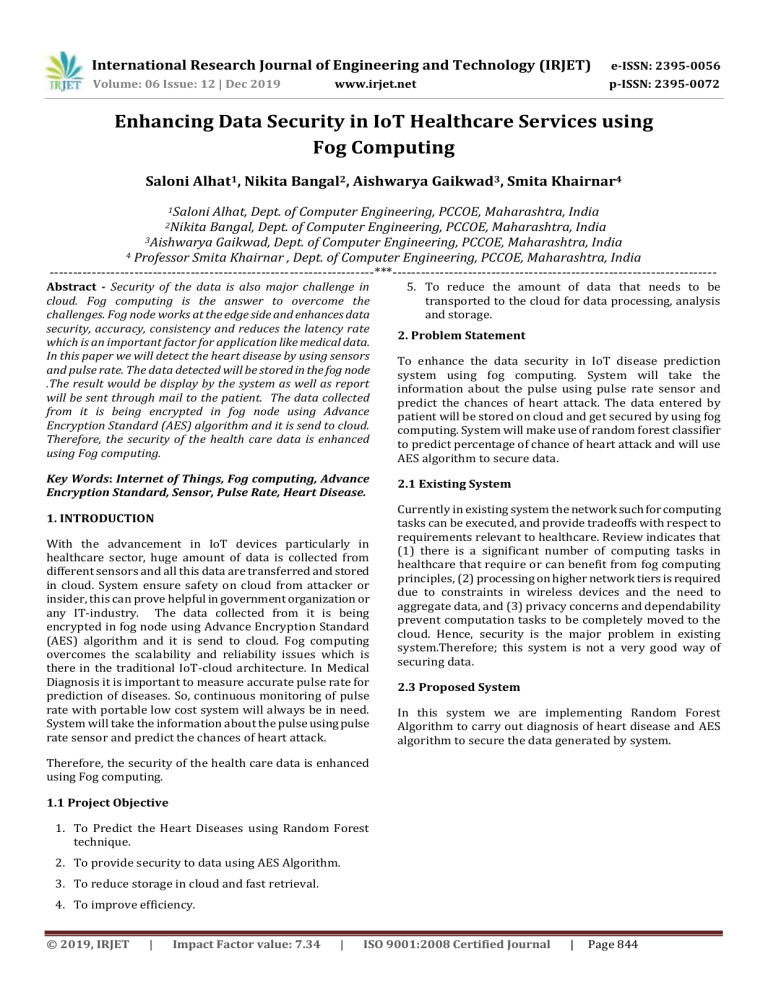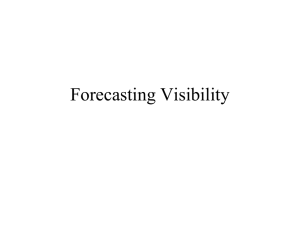IRJET- Enhancing Data Security in IoT Healthcare Services using Fog Computing
advertisement

International Research Journal of Engineering and Technology (IRJET)
e-ISSN: 2395-0056
Volume: 06 Issue: 12 | Dec 2019
p-ISSN: 2395-0072
www.irjet.net
Enhancing Data Security in IoT Healthcare Services using
Fog Computing
Saloni Alhat1, Nikita Bangal2, Aishwarya Gaikwad3, Smita Khairnar4
1Saloni
Alhat, Dept. of Computer Engineering, PCCOE, Maharashtra, India
Bangal, Dept. of Computer Engineering, PCCOE, Maharashtra, India
3Aishwarya Gaikwad, Dept. of Computer Engineering, PCCOE, Maharashtra, India
4 Professor Smita Khairnar , Dept. of Computer Engineering, PCCOE, Maharashtra, India
---------------------------------------------------------------------***--------------------------------------------------------------------2Nikita
Abstract - Security of the data is also major challenge in
cloud. Fog computing is the answer to overcome the
challenges. Fog node works at the edge side and enhances data
security, accuracy, consistency and reduces the latency rate
which is an important factor for application like medical data.
In this paper we will detect the heart disease by using sensors
and pulse rate. The data detected will be stored in the fog node
.The result would be display by the system as well as report
will be sent through mail to the patient. The data collected
from it is being encrypted in fog node using Advance
Encryption Standard (AES) algorithm and it is send to cloud.
Therefore, the security of the health care data is enhanced
using Fog computing.
Key Words: Internet of Things, Fog computing, Advance
Encryption Standard, Sensor, Pulse Rate, Heart Disease.
1. INTRODUCTION
With the advancement in IoT devices particularly in
healthcare sector, huge amount of data is collected from
different sensors and all this data are transferred and stored
in cloud. System ensure safety on cloud from attacker or
insider, this can prove helpful in government organization or
any IT-industry. The data collected from it is being
encrypted in fog node using Advance Encryption Standard
(AES) algorithm and it is send to cloud. Fog computing
overcomes the scalability and reliability issues which is
there in the traditional IoT-cloud architecture. In Medical
Diagnosis it is important to measure accurate pulse rate for
prediction of diseases. So, continuous monitoring of pulse
rate with portable low cost system will always be in need.
System will take the information about the pulse using pulse
rate sensor and predict the chances of heart attack.
5. To reduce the amount of data that needs to be
transported to the cloud for data processing, analysis
and storage.
2. Problem Statement
To enhance the data security in IoT disease prediction
system using fog computing. System will take the
information about the pulse using pulse rate sensor and
predict the chances of heart attack. The data entered by
patient will be stored on cloud and get secured by using fog
computing. System will make use of random forest classifier
to predict percentage of chance of heart attack and will use
AES algorithm to secure data.
2.1 Existing System
Currently in existing system the network such for computing
tasks can be executed, and provide tradeoffs with respect to
requirements relevant to healthcare. Review indicates that
(1) there is a significant number of computing tasks in
healthcare that require or can benefit from fog computing
principles, (2) processing on higher network tiers is required
due to constraints in wireless devices and the need to
aggregate data, and (3) privacy concerns and dependability
prevent computation tasks to be completely moved to the
cloud. Hence, security is the major problem in existing
system.Therefore; this system is not a very good way of
securing data.
2.3 Proposed System
In this system we are implementing Random Forest
Algorithm to carry out diagnosis of heart disease and AES
algorithm to secure the data generated by system.
Therefore, the security of the health care data is enhanced
using Fog computing.
1.1 Project Objective
1. To Predict the Heart Diseases using Random Forest
technique.
2. To provide security to data using AES Algorithm.
3. To reduce storage in cloud and fast retrieval.
4. To improve efficiency.
© 2019, IRJET
|
Impact Factor value: 7.34
|
ISO 9001:2008 Certified Journal
|
Page 844
International Research Journal of Engineering and Technology (IRJET)
e-ISSN: 2395-0056
Volume: 06 Issue: 12 | Dec 2019
p-ISSN: 2395-0072
www.irjet.net
F= Fog node
F={F1, F2, …, Fn}
3.O= Output, Percentage of getting heart attack
O={O1, O2, …, On}
3. Techniques and Algorithm
3.1. AES Algorithm
Advanced Encryption Standard (AES) algorithm is one on the
most common and widely symmetric block cipher algorithm
used in worldwide. This algorithm has an own particular
structure to encrypt and decrypt sensitive data and is
applied in hardware and software all over the world. It is
extremely difficult to hackers to get the real data when
encrypting by AES algorithm.
3.2. Random Forest
Random forest can be used as classification as well as
regression task. Random forest algorithm is the combination
of “Bootstrap aggregating method” and random subspace
method to build various decision tree. Random forest is an
ensemble classifier based on large number of decision tree.
Each decision tree gives the individual outcome by analyzing
the condition. The class having the more votes consider as a
models prediction. It is a supervised machine learning
algorithm.
Fig .1- Proposed System
2.4 Mathematical Model
To check the generalized algorithm in random forest, and
upper bound is derived. This error is consisting of two
parameter mainly,
Let S be a system which predicts the percentage of getting
heart attack. S is defined as
1. The Accuracy of individual classifier.
S={ I, A, O }
2. The dependency between the individual classifiers.
Where,
I= Input, which pulse rate sensor can sense
A= constraints for heart attack
F= Fog computing and security
O= Output, Percentage of getting heart attack
Flow of system:
1. Pulse sensor sense the input data of the patient. Also it will
take the details of the patient.
I= {Pi1, Pi2, … ,Pin}
2. Save the data on cloud and maintain a fog node for
security. Apply the constraints on input.
A= constraints for heart attack
A={A1, A2, … , An}
© 2019, IRJET
|
Impact Factor value: 7.34
|
Fig .2- Random Forest
4. CONCLUSION
The System Analyse the pulse rate and Predicts the Heart
Diseases. The data in the system is secured by using AES
algorithm which is mostly used to encrypt the data. Stored
data predict the patients health report by using random
forest algorithm. System enhances data security, accuracy,
ISO 9001:2008 Certified Journal
|
Page 845
International Research Journal of Engineering and Technology (IRJET)
e-ISSN: 2395-0056
Volume: 06 Issue: 12 | Dec 2019
p-ISSN: 2395-0072
www.irjet.net
consistency, reduces the latency rate and enhances the
overall quality of service. The data stored on the Fog can be
stored in a secure way. The system maintains data integrity.
System protects against misuse of real user data.
REFERENCES
[1] Yumnam Winnie, Umamaheswari E, D M Ajay,
“Enhancing Data Security in IOT Healthcare Services using
Fog Computing”, International Conference on Recent Trends
in Advanced Computing, 2018.
[2] Kraemer, Frank Alexander, Anders Eivind Braten,
Nattachart
Tamkittikhun, and David Palma, “Fog
Computing in Healthcare–A Review and Discussion.”, IEEE
Access 5, 2017.
[3] Al Hamid, Hadeal Abdulaziz, Sk Md Mizanur Rahman, M.
Shamim Hossain, Ahmad Almogren, and Atif Alamri, “A
Security Model for Preserving the Privacy of Medical Big
Data in a Healthcare Cloud Using a Fog Computing Facility
With Pairing-Based Cryptography.”, IEEE Access 5, 2017.
[4] Alrawais, Arwa, Abdulrahman Alhothaily, Chunqiang Hu,
and
Xiuzhen Cheng, “Fog computing for the internet of
things: Security and privacy issues.”, IEEE Internet
Computing 21, 2017.
[5] Reddy Prasad, Pidaparthi Anjali, S.Adil, .Deepa,”Heart
Disease Prediction using Logistic Regression Algorithm using
machine Learning”, International Journal of Engineering and
Advanced Technology (IJEAT) ISSN: 2249 – 8958, Volume-8,
Issue-3S, February 2019.
[6] Rahmani, A. M., Gia T.N., Negash B., Anzanpour A., Azimi
I., Jiang M., and Liljeberg P.: Exploiting smart e-health
gateways at the edge of healthcare internet-of-things: a fog
computing approach. Future Generation Computer Systems,
78, 641-658 (2018).
[7] Goyal, Abhishek, Kanika Narang, Gautam Ahluwalia, P. M.
Sohal, Bhupinder Singh, Shibba T. Chhabra, Naved Aslam,
Bishav Mohan, and Gurpreet S. Wander, ”Seasonal variation
in 24 h blood pressure profile in healthy adults-A
prospective observational study.” Journal of human
hypertension, 2019.
[8]https://blog.oureducation.in/cloud-computinganemerging-technology
[9]http://internetofthingsagenda.techtarget.com/definition/
fog-computing-fogging
[10]https://www.youtube.com/watch?v=pdmyYbdLnkI
© 2019, IRJET
|
Impact Factor value: 7.34
|
ISO 9001:2008 Certified Journal
|
Page 846



